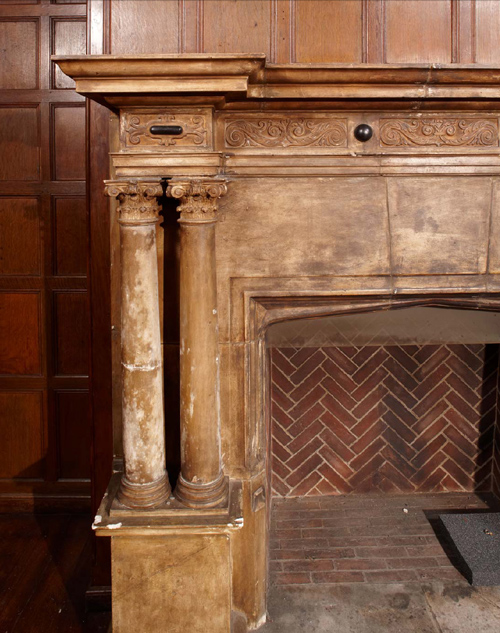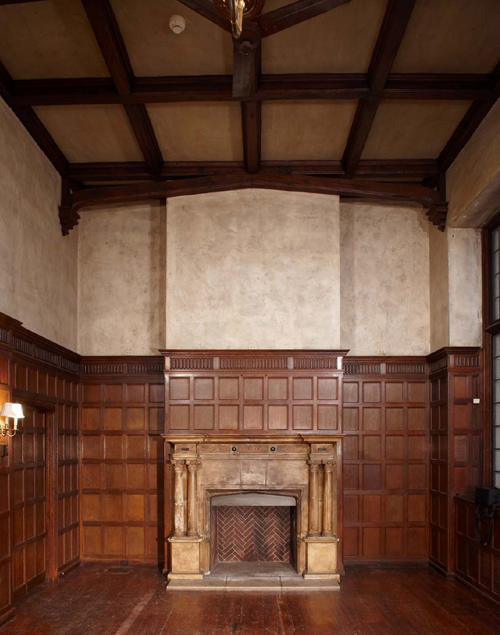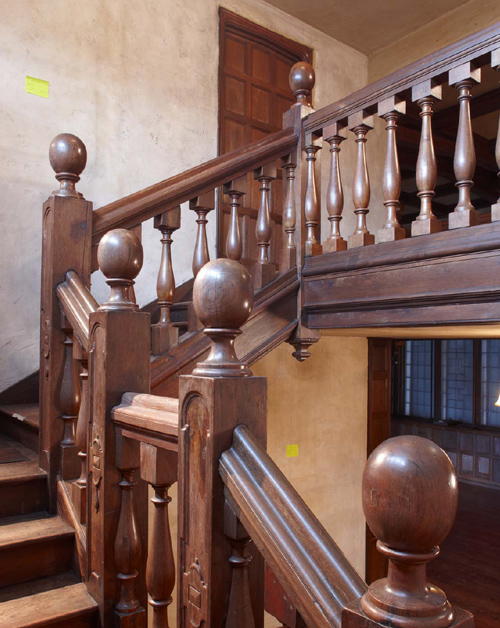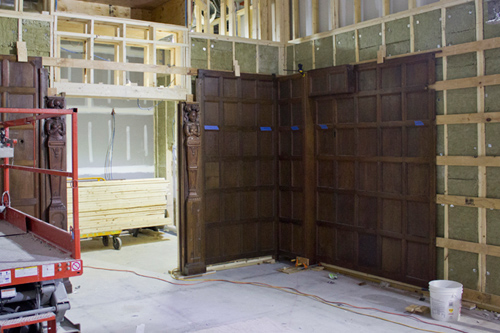It’s not every day that a donor gives her entire living room to a museum.
In 1930 Nettie Naumburg did just that: she bequeathed her common room—which included a foyer and dining room—from her apartment in the famous Hotel des Artistes that she shared with her husband, Aaron Naumburg, to the Fogg Museum. And she gave the Fogg everything in that room: the floors, stairway, ceiling, two-story tall Jacobean hall, English paneling, Swiss stained-glass windows, tapestries, textiles, sculptures, pottery, furniture, and a collection of about 20 paintings, including works by artists such as Rembrandt and Bartolomé Murillo. (Bulletin of the Fogg Art Museum 1932)
All of the room’s elements were dismantled and shipped from New York City to Cambridge, where they were installed in a custom-built wing at the Fogg. By 1932 the room appeared precisely as it had in New York.
At the opening of the Naumburg Room, Mrs. Naumburg’s nephew, James N. Rosenberg, addressed a crowd that had gathered to celebrate the occasion:
This room and all its contents, its very walls, have now, by a magic carpet, been transported to this place . . . Mr. and Mrs. Naumburg had spent many years in the delightful preoccupation of art lovers who gather rare and beautiful things and make them into a home. So they rigorously educated themselves in art, continuously discarding lesser for finer things. In their latter days they gave much thought as to the disposition of this room and of the things in it. They wanted this room to live and to be lived in. (Rosenberg 1932)
In keeping with Mrs. Naumburg’s will, which specified that her apartment “shall be used as living rooms for the purpose of receptions, meetings, study, musicales, a place for the giving of addresses dealing with art, or receptions to artists or scholars” (Naumburg 1930), this space remained a commons for the Harvard community. For over 70 years, the room was used for classes, parties, and lunches for faculty, students, and staff. It was also the site of a weekly coffee hour for Harvard Art Museums employees.
In 2008, when the Harvard Art Museums began a massive renovation project to restore and expand our historic building that housed the Fogg, it was necessary to take apart and move the room once again.
The approximately 10,000 pieces contained in the Naumburg Room were deinstalled and packed into 73 crates. Since the space had functioned as a living room for so many years, this renovation project provided an opportunity to refresh the space. Conservators from the museums’ Straus Center for Conservation and Technical Research worked with contractors to conserve stained-glass panels, refinish wood panels, and recreate plasterwork that had become discolored from years of smoking (yes, that’s right—long ago people were allowed to smoke in the museums).
This past May, the crates were taken out of storage and brought back to the Harvard Art Museums. Over the course of the next few months, the room will be reinstalled in an improved location in our new facility still undergoing renovation.
The Naumburg Room will retain its period charm, but will be equipped with features that make the space more functional for 21st-century needs, such as audiovisual equipment, climate control, and custom lighting, making it an ideal space for meetings, classes, and special events for the museums and Harvard University. The Naumburg Room’s staircase and balcony, which in its previous location didn’t connect to any other room in the Fogg, will now lead to the director’s office and curatorial suites, providing a direct link to the museums’ leadership.
Mrs. Naumburg envisioned that “her beloved room would be a living room for living people to whom art is a living thing” (Rosenberg 1932), and that is exactly what the space will continue to be when the Harvard Art Museums opens in fall 2014.
“The Naumburg Wing,” Bulletin of the Fogg Art Museum 2, no. 1 (Nov. 1932): 18. James Rosenberg. “The Magic Carpet,” notes from his address at the Fogg Art Museum, Cambridge, MA, November 9, 1932. Courtesy Harvard Art Museums Archives, Cambridge, MA. Nettie G. Naumburg, will, dated January 22, 1930. Courtesy Harvard Art Museums Archives, Cambridge, MA.












